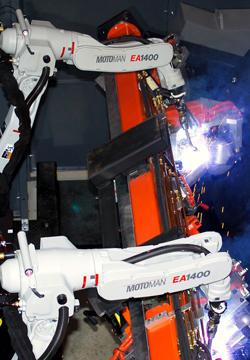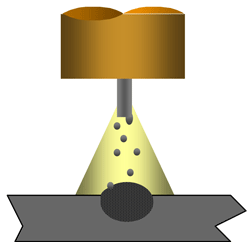- FMA
- The Fabricator
- FABTECH
- Canadian Metalworking
Optimizing the Robotic Welding Process
Often overlooked, welding wire can have a significant impact on quality and productivity
- By Peter Cortina
- August 1, 2010
- Article
- Welding
Robotic welding systems have become increasingly popular in industries that require speed and repeatability to maintain a high volume of productivity.
In addition to delivering fast, accurate air movements that help reduce cycle times, robotic welding systems can repeatedly and precisely position a welding torch with an accuracy of a few thousandths of an inch. In doing so, these systems deliver quick, precise arc-on performance that exceeds the capabilities of a human welder.
Justifying the purchase of a robotic welding system, on the one hand then, is quite simple: it’s man versus machine. But there is definitely more to establishing and maintaining a successful robotic welding system.
Extracting a good return on investment for these systems results from careful planning, selecting the right robot and power sources, and choosing the most appropriate welding wire.
In fact, the welding wire is often one of the most overlooked components in a robotic welding system. It is also one that can have a significant impact on quality, productivity, and cost. In many cases, companies can optimize the expected return on their robotic system by converting from the industry-standard solid wire to a metal-cored wire.
Choosing Welding Wire
Typically, a robot spends 20 to 30 percent of the cycle time for air movements - moving to and from the weld joint. The remaining 70 to 80 percent of the cycle represents arc-on time during which the welding consumable greatly impacts the total cycle time.
Solid Wire. For many years solid wire has been the industry standard for robotic welding. Its dominance is due primarily to its availability and low unit cost. Solid wire is particularly effective for welding on thin-gauge materials, allowing manufacturers to use a 0.035-in.-diameter wire, for example, to weld at low amperages.
Such solid-wire applications are common in the automotive industry, metal furniture manufacturing, and in other thin-gauge metal applications using pulsed welding.
Solid wire, like any consumable, has both merits and deficits. Often it can provide the quality that a company desires for its application. However, in some situations, especially when higher travel speeds are necessary, solid wire requires greater heat input and tends to increase the risk of burn-through as a result.
Historically, solid wire is also prone to creating spatter, and it creates a fingerlike penetration profile that does not bridge gaps between parts as readily as a consumable like metal-cored wire.
When spatter, burn-through, or other quality defects occur, companies very often undertake various activities to combat them.
These activities are considered non-valued-added because they do not contribute directly to the overall productivity of the robotic welding system. Grinding, using antispatter spray in the preweld stage, cleaning of spatter in the weld and postweld stage, and incorporating repair and rework stations in the postweld stage are all examples of non-value-added activities.
Metal-cored Wire. While solid wire is usually applicable for a large number of welding applications, many could also benefit from the use of metal-cored wire. To determine which applications are good candidates for the product, it is important to consider the key features associated with metal-cored wire.
At equivalent amperage settings, a metal-cored wire carries a higher current density than a solid wire. That is because metal-cored wire consists of a hollow metal sheath filled with metallic powders, alloys, and arc stabilizers.
During the welding process (spray transfer), the current travels through the outside metal sheath, rather than being conducted through a solid wire’s entire cross-sectional area. This feature results in a higher relative burnoff rate, better deposition rate, and faster travel speed compared to solid wire.
In short, metal-cored wire can even eliminate non-value-added activities throughout the welding process. Let’s take a closer look.
Welding Stages, Activities, Cost
A typical robotic welding application has three distinct stages: preweld, weld, and postweld. Often the greatest opportunity for cycle time improvement with metal-cored wires is in the preweld and postweld stages.
Preweld. Part tacking and loading are common activities of the preweld stage, but welding operators also spend large amounts of time for precleaning activities before the robotic system does its job.
As mentioned previously, these activities include sandblasting, grinding, and applying antispatter. Metal-cored wire has added deoxidizers, alloys, and arc stabilizers in its core that typically reduce the need for such precleaning activities.
These special formulations make metal-cored wire suitable for welding through mill scale, the fine oxide layer found on hot-rolled steels, so sandblasting and grinding usually are unnecessary. Metal-cored wire also generates very little to no spatter, eliminating the need for antispatter spray applications. Companies operating robotic welding systems can then reduce the time, labor, and cost for such preweld activities and send parts straight to the weld cell.
Weld. As a rule, metal-cored wire can increase deposition rates significantly, a feature that allows the robot to weld on both thin and thick materials with low heat input. Metal-cored wire also provides stable arc initiation and smooth arc transfer.
The molten metal droplets formed during welding with metal-cored wire are smaller and their projection is generally wider than with solid wire. These characteristics provide a more effective and complete metal transfer, and create less turbulence in the weld pool, which in turn reduces spatter and improves deposition efficiency.
Metal-cored wire also bridges gaps easier and reduces problems associated with part fit up variance because of its broader arc. This feature ultimately reduces the need for rework in the postweld cell.
Postweld. Using metal-cored wire typically reduces or eliminates the need for postweld spatter cleaning operations, along with repair or rework stations. This may allow for reallocation of labor elsewhere in the welding operation.
In fact, analyzing the cost of these activities also reveals the postweld stage to be the greatest area of opportunity for optimizing robotic applications using metal-cored wire. Simply stated, by eliminating activities here, companies can lower costs and gain a faster return on their investment in their robotic welding system. Plus, less postweld activity improves the flow of completed parts to other stages of production, such as painting or coating, to improve overall productivity.
Companies make large capital investments in robotic welding systems, expecting a very fast payback in return. In many cases they achieve it, but certainly not by accident. The return is the result of careful planning, including the decision about which type of welding wire to use.
And while metal-cored wire is not suitable for every situation and has a higher unit cost, sometimes robotic systems can benefit from it.
Still, it is important to remember that whatever welding consumable is chosen, the goal is the same: to optimize the potential of the robotic system and gain the return on investment that initially fueled the decision to invest in welding automation.
For more information, visit www.hobartbrothers.com.
subscribe now


Keep up to date with the latest news, events, and technology for all things metal from our pair of monthly magazines written specifically for Canadian manufacturers!
Start Your Free Subscription- Trending Articles
- Industry Events
MME Winnipeg
- April 30, 2024
- Winnipeg, ON Canada
CTMA Economic Uncertainty: Helping You Navigate Windsor Seminar
- April 30, 2024
- Windsor, ON Canada
CTMA Economic Uncertainty: Helping You Navigate Kitchener Seminar
- May 2, 2024
- Kitchener, ON Canada
Automate 2024
- May 6 - 9, 2024
- Chicago, IL
ANCA Open House
- May 7 - 8, 2024
- Wixom, MI
















